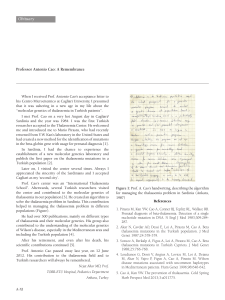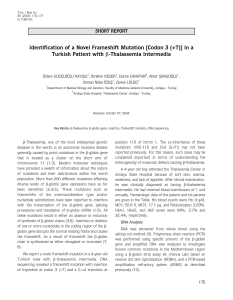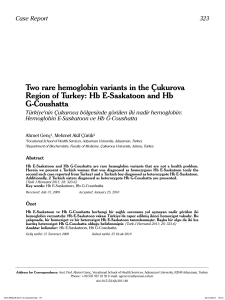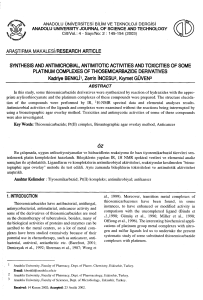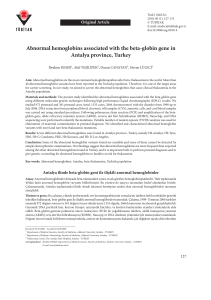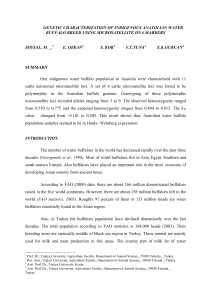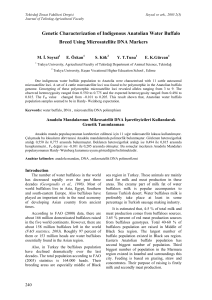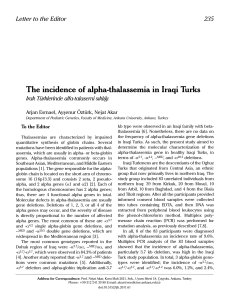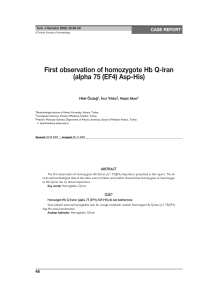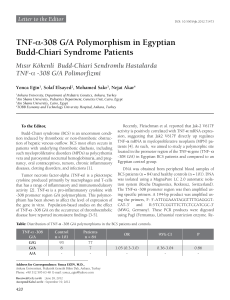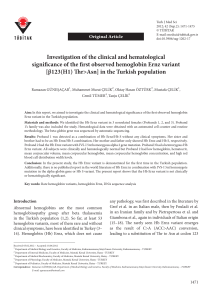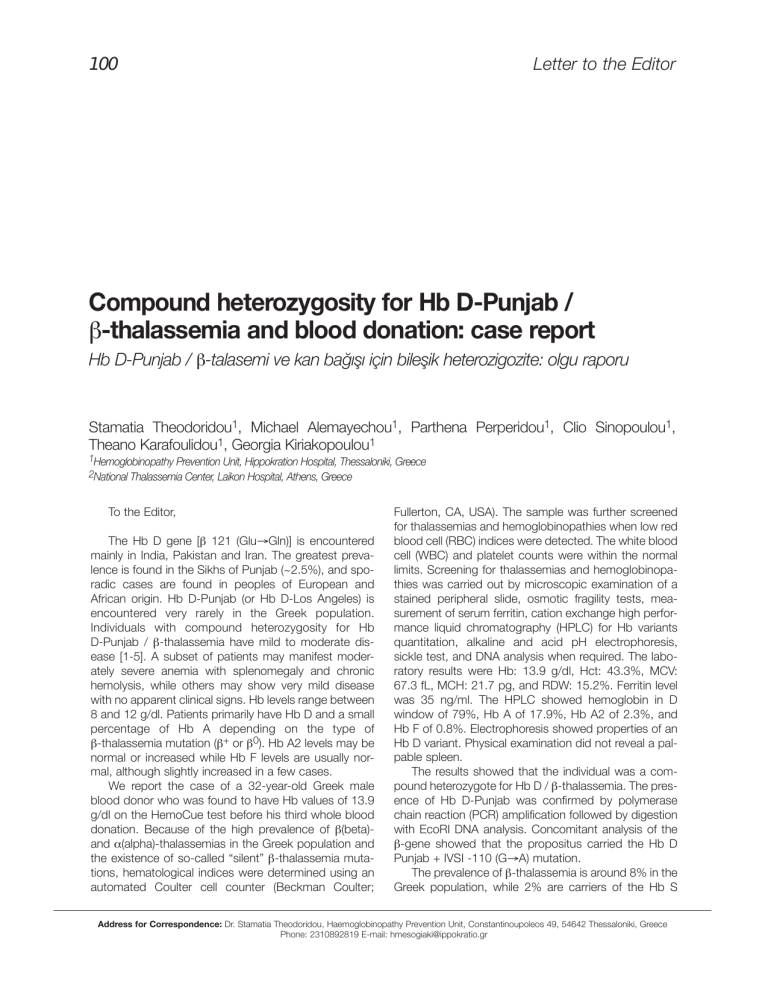
100
Letter to the Editor
Compound heterozygosity for Hb D-Punjab /
β-thalassemia and blood donation: case report
Hb D-Punjab / β-talasemi ve kan bağışı için bileşik heterozigozite: olgu raporu
Stamatia Theodoridou1, Michael Alemayechou1, Parthena Perperidou1, Clio Sinopoulou1,
Theano Karafoulidou1, Georgia Kiriakopoulou1
1Hemoglobinopathy Prevention Unit, Hippokration Hospital, Thessaloniki, Greece
2National Thalassemia Center, Laikon Hospital, Athens, Greece
To the Editor,
The Hb D gene [β 121 (Glu→Gln)] is encountered
mainly in India, Pakistan and Iran. The greatest prevalence is found in the Sikhs of Punjab (~2.5%), and sporadic cases are found in peoples of European and
African origin. Hb D-Punjab (or Hb D-Los Angeles) is
encountered very rarely in the Greek population.
Individuals with compound heterozygosity for Hb
D-Punjab / β-thalassemia have mild to moderate disease [1-5]. A subset of patients may manifest moderately severe anemia with splenomegaly and chronic
hemolysis, while others may show very mild disease
with no apparent clinical signs. Hb levels range between
8 and 12 g/dl. Patients primarily have Hb D and a small
percentage of Hb A depending on the type of
β-thalassemia mutation (β+ or β0). Hb A2 levels may be
normal or increased while Hb F levels are usually normal, although slightly increased in a few cases.
We report the case of a 32-year-old Greek male
blood donor who was found to have Hb values of 13.9
g/dl on the HemoCue test before his third whole blood
donation. Because of the high prevalence of β(beta)and α(alpha)-thalassemias in the Greek population and
the existence of so-called “silent” β-thalassemia mutations, hematological indices were determined using an
automated Coulter cell counter (Beckman Coulter;
Fullerton, CA, USA). The sample was further screened
for thalassemias and hemoglobinopathies when low red
blood cell (RBC) indices were detected. The white blood
cell (WBC) and platelet counts were within the normal
limits. Screening for thalassemias and hemoglobinopathies was carried out by microscopic examination of a
stained peripheral slide, osmotic fragility tests, measurement of serum ferritin, cation exchange high performance liquid chromatography (HPLC) for Hb variants
quantitation, alkaline and acid pH electrophoresis,
sickle test, and DNA analysis when required. The laboratory results were Hb: 13.9 g/dl, Hct: 43.3%, MCV:
67.3 fL, MCH: 21.7 pg, and RDW: 15.2%. Ferritin level
was 35 ng/ml. The HPLC showed hemoglobin in D
window of 79%, Hb A of 17.9%, Hb A2 of 2.3%, and
Hb F of 0.8%. Electrophoresis showed properties of an
Hb D variant. Physical examination did not reveal a palpable spleen.
The results showed that the individual was a compound heterozygote for Hb D / β-thalassemia. The presence of Hb D-Punjab was confirmed by polymerase
chain reaction (PCR) amplification followed by digestion
with EcoRI DNA analysis. Concomitant analysis of the
β-gene showed that the propositus carried the Hb D
Punjab + IVSI -110 (G→A) mutation.
The prevalence of β-thalassemia is around 8% in the
Greek population, while 2% are carriers of the Hb S
Address for Correspondence: Dr. Stamatia Theodoridou, Haemoglobinopathy Prevention Unit, Constantinoupoleos 49, 54642 Thessaloniki, Greece
Phone: 2310892819 E-mail: [email protected]
Theodoridou et al.
β-thalassemia - D Punjab compound heterozygosity
Turk J Hematol 2009; 26: 100-1
gene. The gene for Hb D is rare. During the 22 years of thalassemia screening in our Thalassemia Prevention Unit in northern
Greece, 30 cases of heterozygotes for Hb D, 1 case of compound heterozygote for Hb S / Hb D-Punjab and 1 case of
compound heterozygote for β-thalassemia / Hb D-Punjab were
detected, among 80,401 subjects screened. Our Thalassemia
Prevention Unit covers the regions of central and western
Macedonia, in northern Greece, with a population of around
2.5 million.
Hb D/β-thalassemia patients have a disease that has clinical
manifestations ranging from mild to moderate disease, resembling either thalassemia minor or thalassemia intermedia [4].
Our case can be characterized as exceptionally mild,
because the individual was not aware of the disease until it was
found on routine pre-donation Hb measurement for his third
whole blood donation. He is healthy in appearance and had
donated on two previous occasions without untoward effects.
He is now exempted from whole blood donation for fear of
long- term consequences, although one can argue that, similar
to those with the thalassemia trait, this individual could be kept
on a program of long-term blood donation if it is infrequently
101
done and if Hb values are stringently followed. It is also equally important that the use of such RBCs for transfusion be
studied. This report confirms the benign nature of co-inheritance of Hb D-Punjab and β+-thalassemia.
References
1.
2.
3.
4.
5.
Rahimi Z, Akramipour R, Korani S, Nagel RL. Hb D-Punjab [β
121(GH4) Glu-Gln]/βο-thalassemia [IVSII.1(G-A)] in two cases
from an Iranian family: first report. Am J Hematol 2006;81:302-3.
Perea FJ, Casas-Castaneda M, Villalobos-Arambula AR, Barajas
H, Alvarez F, Camacho A, Hermosillo RM, Ibarra B. Hb D-Los
Angeles associated with Hb S or β-thalassemia in four Mexican
Mestizo families. Hemoglobin 1999;23:231-7.
Adekile AD, Kazanetz EG, Leonova JY, Marouf R, Khmis A,
Huisman TH. Co-inheritance of Hb D-Punjab (codon 121:GAAGAA and beta (0) thalassemia (IVSII-1;G-A). J Pediatr Hematol
Oncol 1996;18:151-3.
Weatherall DJ, Glegg JB. The Thalassemia Syndromes. 4th ed.
Oxford (UK): Blackwell Science, 2001.
Tsistrakis GA, Scampardonis GJ, Clonizakis JP, Concouris LL.
Haemoglobin D and D thalassaemia. A family report, comprising
18 members. Acta Haematol 1975;54:172-9.

